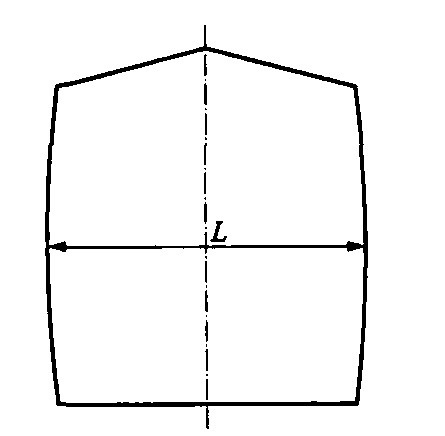Aerodynamic performance of sidewall shape of boxcar under strong crosswind
-
摘要: 强横风引起的气动横向力和气动升力是造成列车被吹翻事故的主要原因。空棚车由于其侧壁迎风面积大且质量轻, 很容易在强横风作用下发生倾覆事故。采用流场数值计算方法, 对垂直侧壁、弧形侧壁和外折形侧壁3种棚车外形方案, 研究了横风作用下的棚车空气动力特性: 气动横向力、升力和气动倾覆力矩。研究结果表明: 车体受到的气动倾覆力矩主要是由气动横向力产生的; 弧形侧壁和折形侧壁可以有效地改善车辆横向气动性能, 降低车辆的气动倾覆力矩, 提高车辆的稳定性; 与垂直侧壁棚车相比, 当车体宽度为3.2 m时, 弧形侧壁和外折形侧壁棚车的气动倾覆力矩均可以下降21%左右, 空载棚车倾覆临界风速可以提高2.7 m2·s-1。Abstract: The transverse force and air lift force caused by strong crosswind are the main factors of train overturning, unloaded boxcar can easily be overturned by strong crosswind because of its large sidewall area and underweight.So flow field numerical computation was completed in order to look for an optimum project of sidewall shape among the upright sidewall, bulgy-arc sidewall and bulgy-slope sidewall, the aerodynamic performance of boxcar suffering from crosswind was studied, such as the transverse air force, air lift force and overturning moment.The result shows the bulgy-arc sidewall and bulgy-slope sidewall can reduce the overturning moment effectively and improve train's stability under strong crosswind to greater extent than the upright sidewall, when the width of boxcar is 3.2 m, boxcar sidewall with bulgy-arc and bulgy-slope compared with upright, its coefficient of overturning moment decreases to about 21% and the critical wind speed increases to 2.7 m2·s-1 for unloaded boxcar.
-
Key words:
- vehicle engineering /
- boxcar /
- aerodynamics /
- numerical simulation /
- crosswind /
- shape
-
表 1 弧形侧壁气动力系数
Table 1. Aerodynamic coefficients of bulgy-arc sidewall
工况 1 2 3 4 5 车体宽度/m 2.820 2.915 3.010 3.105 3.200 气动横向力系数 1.92 1.76 1.58 1.55 1.47 气动升力系数 0.08 0.10 0.23 0.28 0.40 气动倾覆力矩系数 0.80 0.74 0.68 0.67 0.66 表 2 折形侧壁气动力系数
Table 2. Aerodynamic coefficients of slope sidewall
工况 6 7 8 9 10 11 12 13 侧壁最大宽度部位的高度/m 0.47 0.67 0.77 0.87 0.97 1.07 1.27 1.47 气动横向力系数 1.55 1.53 1.51 1.52 1.55 1.55 1.55 1.58 气动升力系数 0.23 0.34 0.33 0.37 0.34 0.35 0.38 0.31 气动倾覆力矩系数 0.69 0.68 0.66 0.68 0.69 0.69 0.69 0.69 -
[1] 京沪高速铁路技术研究总体组. 京沪高速铁路侧向风、强降雨对行车的影响及安全限值的调查研究[R]. 北京: 铁道部科学研究院, 2002. [2] 乌鲁木齐铁路局科委. 兰新复线防风安全工程[J]. 中国铁路, 1995, 35 (10): 30-43. https://www.cnki.com.cn/Article/CJFDTOTAL-TLZG199510043.htmScience and Technique Committee of Urumchi Railway Bureau. Windbreak safety engineering of Lanchow-Sinkiang railway line[J]. China Railway, 1995, 35 (10): 30-43. (in Chinese) https://www.cnki.com.cn/Article/CJFDTOTAL-TLZG199510043.htm [3] Coleman S A, Baker C J. High sided road vehicles in cross winds[J]. Journal of Wind Engineering and Industrial Aerodynamics, 1990, 36 (2): 1 383-1 392. [4] 高广军, 田红旗. 兰新线强横风对车辆倾覆稳定性的影响[J]. 铁道学报, 2004, 26 (4): 36-41. doi: 10.3321/j.issn:1001-8360.2004.04.008Gao Guang-jun, Tian Hong-qi. Effect of strong cross-wind on the stability of trains running on the Lanzhou-Xinjiang railway line[J]. Journal of the China Railway Society, 2004, 26 (4): 36-41. (in Chinese) doi: 10.3321/j.issn:1001-8360.2004.04.008 [5] 白虎志, 李栋梁, 董安祥, 等. 青藏铁路沿线的大风特征及风压研究[J]. 冰川冻土, 2005, 27 (1): 111-116. doi: 10.3969/j.issn.1000-0240.2005.01.017Bai Hu-zhi, Li Dong-liang, Dong An-xiang, et al. Strong wind and wind pressure alongthe Qinghai-Tibet railway[J]. Journal of Glaciology and Geocryology, 2005, 27 (1): 111-116. (in Chinese) doi: 10.3969/j.issn.1000-0240.2005.01.017 [6] 梁习锋, 熊小慧, 易仕和. 强侧风作用下棚车气动外形优化[J]. 国防科技大学学报, 2006, 28 (2): 30-34. https://www.cnki.com.cn/Article/CJFDTOTAL-GFKJ200602005.htmLiang Xi-feng, Xiong Xiao-hui, Yi Shi-he. Optimization research of aerodynamic figure of the boxcar under crosswinds[J]. Journal of National University of Defense Technology, 2006, 28 (2): 30-34. (in Chinese) https://www.cnki.com.cn/Article/CJFDTOTAL-GFKJ200602005.htm [7] 田红旗, 周丹, 许平. 列车空气动力性能与流线型头部外形[J]. 中国铁道科学, 2006, 27 (3): 47-55. https://www.cnki.com.cn/Article/CJFDTOTAL-ZGTK200603008.htmTian Hong-qi, Zhou Dan, Xu Ping. Aerodynamic performance and streamlined head shape of train[J]. China Railway Science, 2006, 27 (3): 47-55. (in Chinese) https://www.cnki.com.cn/Article/CJFDTOTAL-ZGTK200603008.htm [8] 田红旗. 中国列车空气动力学研究进展[J]. 交通运输工程学报, 2006, 6 (1): 1-9. doi: 10.3321/j.issn:1671-1637.2006.01.001Tian Hong-qi. Study evolvement of train aerodynamics in China[J]. Journal of Traffic and Transportation Engineering, 2006, 6 (1): 1-9. (in Chinese) doi: 10.3321/j.issn:1671-1637.2006.01.001 -





 下载:
下载:




